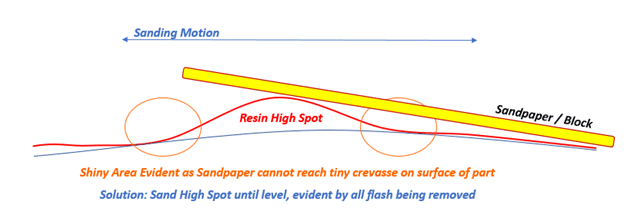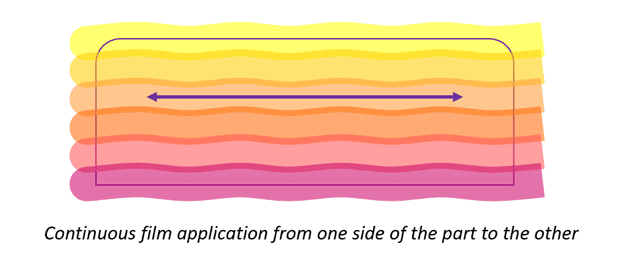There are many ways to achieve a mirror finish for fabricated parts. The exact process used may vary depending on the part type and the desired finish. We’ll also present various examples of why pinholes could be plaguing a given part and some best practices on how to eliminate them from the clear coating application process. There is a high amount of fine detail that goes into clear coating a part. These fine details in prep, selection, and application can make the difference in hours of extra sanding or kicking back to enjoy a clear coated
carbon fiber work of art.
These types of unforeseen Foreign Object Debris (FOD) from the release agent may be the cause of clear coat application issues. Even with a quality wet-out laminate and light sanding from prep, residual silicone or wax from the mold release used on the mold may linger and lead to bonding issues with the clear coat to the resin. Most often this will lead to more than just pinholes.
Best Practice: Use a silicone and wax remover, degreaser, or IPA with a rag or lightly applied with a drenched scotch-brite pad before ever sanding the part. The goal here is to get everything off the part that may have been associated with its cure. Silicone is simply EVIL in terms of clear coating. Keep ANYTHING containing Silicone AWAY from the laminates being clear coated and the process of application.

Another common cause of pinholes in clear application is exposed fibers on the surface of the laminate. Exposed Fibers may likely stem from an array of possible errors in resin introduction to the part during infusions or from bagging errors in prepregs or traditional layups. Traits of these types of errors are a rough mold side finish or pinhole type indentions in a part. The resin introduction, or lack thereof, may lead to pinholes in the clear coat application as shown in the right example of exposed fibers. Exposed fibers may also be found if parts are over sanded during the prep process. Instead of a white or light gray film while sanding, there is black carbon dust evident during the sanding or cleaning process. In the case of exposed fibers, a clear coat will not stick to these areas, causing a pinhole or pitting issues upon application.

In a perfect world, with all residual silicone removed and a completely wet-out and prepared part surface, application for clear is made simpler. But still not necessarily easy by any means. Sure, seasoned professionals may breeze through without any issue, but for most DIY composite fabricators, it can be trial and error, which is EXPENSIVE! Clear Prep for a clear coat effectively lies in knowing what details are important versus what can just be sanded out.
Knowing how to effectively sand a part is critical in achieving a properly prepared part for a clear coat. Sanding is important because it gives the clear coat something to bond to on the resin’s surface. Clear coat will not bond well to an already shiny, possibly hydrophobic surface with high surface tension. The correct surface tension must be achieved on the part’s surface for proper adhesion of the clear coat by removing all shine from the part. Sanding, as part of the clear coat prep process, helps to lower surface tension, effectively helping the clear coat grab to the part surface just as prepping for secondary bonding practices. When sanding it is important to achieve uniformity across the entire surface to be clear coated while not exposing fibers. Even after a resin coating, High spots may be evident as areas that still exhibit a flash or shine upon the area being sanded. All high spots need to be removed before clear coat application. The surface needs to be as level, this is usually achieved once the part is completely dull and flat with no tiny minuscule shine coming from the surface of the part.

Grit Size: There are various grit sizes that will be used effectively in different steps of the process, manufacturers of topcoats and clear coats generally call out specifically what grit range works best for a specific product. Note: Most grits can be used for multiple applications. One idea is to go ahead and order a variety packs of sandpapers ranging from ~180 – 600 Grit for clear coating prep and application. Additional higher grits running from 1000 up to 5000 Grit are generally used for polishing of clear coated parts. It is also a good idea to have a range of scotch brite pads, as they are great cleaning and prep tools and are easily applied with IPA or acetone or other cleaning solvent as needed.
Dry Vs Wet Sanding: Dry sanding is often performed when preparing a part for an additional resin layer, top-coating, or clear coating application. Wet sanding is for after clear coating application, as part of the process for bringing the part to a polished shine. Wet sanding helps keep the part surface cool and aids in removing residual dust from the sanded area. Wet sanding is often performed with a simple mixed solution of water and a drop of soap. Soapy water is commonly used to “stretch” the water, lowering its surface tension, making the water more effective for wet sanding.
Orbital Sanders: For larger parts, sanding is aided heavily by orbital sanders, paired with a softening interface pad and needed grit sandpaper being most effective. There are multiple sanding steps associated with achieving a mirror finish clear coat application. Orbital sanders can be used but with caution, especially with heavier abrasive grits. In addition to sanding large surfaces, orbitals are great tools to use for wet sanding clear coated surfaces as part of buffing and polishing processes. Use of Orbital sanders is highly dependent on the size or complexity of the part surface. For hard-to-reach areas, it is advised to use hand sanding techniques to flatten surfaces as needed.
Guide coats: Used to ensure an even surface is achieved before the application of a clear coat. It is one of the most effective tools for sanding and prep operations as it takes the guesswork out of possibly uneven sanding, visually preventing sanding too deep yet ensuring smooth surfaces throughout both prep and polishing processes. Guide coats are used widely across the auto industry as a standard in achieving the highest quality in application. It is as simple as a thin layer of sprayed paint. It helps to ensure clear coat applications are smooth! Guide coats can also be applied in all sanding steps from flat dull surfaces or in wet sanding operations when certain areas may be less apparent to the eye.

Finally, to the clear coat. First, read the manufacturer’s technical data sheet (TDS) for instruction and the safety data sheet (SDS) thoroughly. Safety is key when working with any type of solvent spray and clear coat application. Use of safety equipment including but not limited to respirators, filters, and chemical resistant gloves are a must. We’re okay if you ruin some T-shirts but Tyvek type suits are commonly used for application. A TDS helps clarify details such as the mixing ratio, flash times and spraying pressures that are critical in achieving a successful application. Clear coats are best sprayed by a pneumatically powered HVLP spray gun. Tip size is usually determined by the product’s technical data sheet.
When selecting a clear coat to use there are a few determining factors that may help the decision easier. There are a ton of clear coats to choose from and even those with a high degree of technical experience will argue as to which is best. The better question to ask, what is right for your specific part or project? The characteristics of a clear coat may aid in selection. If your parts are subjected to sunlight, a UV stabilizing clear coat is strongly suggested before going into greater detail of clear coat selection. Solids Content: Choices for clear coats lie generally in Medium Solids (MS) or High Solids (HS) as determining factors in terms of coverage and application thickness for carbon fiber parts. High Solids usually allow a greater degree of covering surface imperfections while
taking a more experienced hand in application to overcome possible runs or sags in the coating over the use of Medium Solids Clear Coats. High Solids Content coatings are great for their post application polishing capabilities when taking clear coating to a showroom type finish. High Solids clears usually hold the ability to brush out or dab out pinholes created during the spray process. Medium Solids aid for an easier application through the gun onto the part. Usually applied in thinner coats as they are less susceptible to runs and sagging.
Hardener & Reducers: Usually a manufacturer will have recommended hardeners and reducers based upon the size of application and temperatures the clear coat will be subjected to while curing. A Medium or Slow type clear coat hardener is commonly used for carbon fiber or composite laminates. Slow hardeners are best used in larger parts such as car hoods or in non-ideal climate conditions such as temperatures above 85F or in higher humidity environments. As parts get smaller in size or climate conditions are more favorable for clear coating, faster and easier evaporation and cure setups can be used. (Such as faster Hardeners and higher reducer mixture rates) Reducers (paint thinners) are used commonly to manipulate the resin viscosity, effectively lowering it, aiding flow through the
HVLP spray gun and tip and helping clear coats to smooth out easier. In addition, acetone has also commonly been used for reducing (thinning) clear coats, resins, paints as needed in applicable use. When using reducers or thinners, experience helps greatly. A splash of reducer or acetone in one product may not yield the same clear coat properties as a splash
in different climate environments.
Flash Times: Past the selection of a clear coat, flash times should be closely monitored when applying multiple coatings of clear. Flash time is the time in which the solvents in a clear coat evaporate and another layer of clear can be applied. Most often this time is listed in the TDS and is at least 15 mins. Minor modifications in the flash time can depend on the type of hardener and the percentage of reducer used.
Ensure Cleanliness: Use a Lint free Towel during prep. Ensure NO BLACK dust is evident before applying a clear coat!! Fold the towel, ensure there is not residual sanding dust getting redistributed on the part. After one wipe continuous wipe, fold to a clean section of towel / rag. Again, NO SILICONE in immediate area
Duratec Sunshield Application Tips:
Check that equipment being used is correct to manufacturer’s recommendations. Think supplied air pressure, correct spray gun types, proper gun cleanliness, or TIP SIZE for example. If new to clear coating, it is highly suggested to test your setup before going to clear coat a possibly expensive carbon fiber part. Try clear coating various substrates like a flat test panel or equivalent. It doesn’t have to be composite, just something that the clear coat will evidently stick to. Ensure your hardener and reducer setup is effective in application given the climate conditions presented.
Ensure that there is no moisture in the air compressor or air lines that could mix in with the clear coat and ruin the application.

